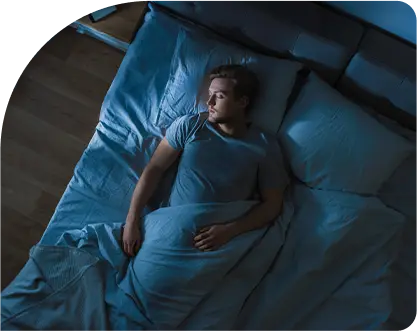The Connection Between Sleep Apnea and Erectile Dysfunction
Published: 2021-06-10
 Updated: 2025-02-05
Updated: 2025-02-05
5 mins
There’s nothing like a good night’s rest. Everyone can agree that when you sleep well, you feel great. Sleep is crucial for maintaining overall health and functionality while we are awake. It is during sleep that our bodies go into a state of rest and undergo various important processes.
While you sleep, your body is recovering and repairing itself from daily wear and tear. It is a time when your muscles and tissues can heal and regenerate so that you function properly during the day.
Sleep is also closely tied to hormonal regulation. Hormones such as testosterone – which plays a crucial role in sexual health – are regulated during sleep. Insufficient sleep disrupts hormone balance, potentially leading to decreased libido and erectile dysfunction (ED).

When we don't get enough sleep on a consistent basis, our bodies experience increased levels of stress and inflammation. These factors can negatively impact blood flow, including the blood flow required for a healthy erection. Insufficient sleep can also affect mood, leading to increased stress, anxiety, and irritability, all of which can further contribute to ED.
For many, ED occurs due to underlying medical conditions involving the circulatory and cardiovascular systems. An erection needs a steady supply of blood, and issues related to blood supply can result in challenges during the erection process. But health experts have begun to explore a possible connection between sexual dysfunction and sleep disorders.
What is Sleep Apnea?
Sleep apnea is a sleep disorder in which breathing is repeatedly interrupted throughout the night, frequently stopping and starting. For the human body to function and operate normally requires almost constant air flow from the mouth and nose into the lungs. During sleeping, this process should continue as normal – even while the other parts and systems of the body are slowed down and resting.
With sleep apnea, air flow is repeatedly interrupted or hindered for various reasons, resulting in several severe side effects. This disorder is relatively common: an estimated 22 million people experience sleep apnea in the United States (with nearly 80% of these cases being undiagnosed).
This is particularly dangerous, as untreated sleep apnea can increase the risks of experiencing hypertension, heart disease, heart failure, irregular heartbeats, stroke, and heart attack.
There are three types of sleep apnea:
Obstructive Sleep Apnea (OSA): The most common type of sleep apnea. This variation occurs when the airway is either narrowed or blocked, obstructing the airway space and interrupting air flow. Snoring is heavily associated with this type of sleep apnea due to the flow of air being squeezed through a smaller and more narrow space than required.
Central Sleep Apnea (CSA): This sleep apnea variation occurs when the brain fails to send the proper messages to the respiratory muscles required to take in air. The most clear symptom of this sleep apnea is suddenly waking up and gasping for breath.
Complex Sleep Apnea Syndrome (CompSAS): A combination of obstructive and central sleep apneas. Often this syndrome will appear as though it’s obstructive sleep apnea, but the breathing patterns will be similar to central sleep apnea, especially during treatment.
What Causes Sleep Apnea?
When obstructive sleep apnea occurs, it's typically due to the relaxation of muscles that are located in the back of the throat. These muscles are responsible for supporting the soft palate of the throat, the uvula, the side walls of the throat, and the tongue. When these muscles are relaxed, these objects close in and narrow the airway as oxygen is being inhaled.
As a result, the brain notices this reduced oxygen level in the bloodstream and wakes the sleeping person in order to reopen the airway. This pattern can occur between five and 30 times an hour and severely impacts sleep quality.
Some of the primary risk factors for obstructive sleep apnea include:
A large or thick neck can cause narrow airways.
An overbite, tonsils, or adenoids can narrow airways.
A small jaw or deep chin can cause narrow airways.
Drinking alcohol or using sedatives can further relax the muscles in the throat and may create or worsen sleep apnea.
Genetics might play a role as sleep apnea may be an inherited familial trait.
Men are nearly three times more likely to develop sleep apnea than women.
Obesity and excess weight greatly increase the risk of sleep apnea as fat deposits in the upper airway can severely impact breathing.
Sleeping on your back can relax muscles and reduce air flow.
Smoking increases inflammation and fluid in the upper airway and increases the odds of sleep apnea by up to three times.
Central sleep apnea is a little more complicated, as it involves the CNS failing to perform its function. For the most part, this is found in people with neurological disorders or brain damage, but having a stroke, heart disorder, or history of opioid abuse increases the risks of developing central sleep apnea.
What are the Symptoms of Sleep Apnea?
Sleep apnea is a serious medical condition. If you think you might be experiencing sleep apnea, you should consider seeing a doctor about potential treatments.
These are some of the potential symptoms associated with sleep apnea:
A loss of interest in sex and decreased libido
Difficulty falling asleep
Difficulty staying awake
Drowsiness and nodding off
Edema or swelling in the legs
Forgetfulness and memory trouble
Frequent urination in the night
Headaches or migraines upon waking
Heart related issues
Hypersomnia or excessive daytime fatigue and sleepiness
Hypertension or high blood pressure
Irritability and anger issues
Issues with concentration, focus, and paying attention
Loud and excessive snoring (most commonly with OSA)
Poor performance at work or school
Slower metabolism
Sore throat or dry mouth upon waking
Waking up gasping for air with a shortness of breath (most commonly with CSA)
Worsening depression
What Does Sleep Apnea Have to Do with Erectile Dysfunction?
You might be asking yourself what this sleep condition has anything to do with an inability to get an erection. Well, as mentioned before, not sleeping properly can take a toll on sexual health – and sleep apnea does just that.
Many studies have noted the link between sleep apnea and erectile dysfunction.
In one study, over half of the men experiencing erectile dysfunction also had symptoms similar to obstructive sleep apnea. Another study found that nearly 70% of the participants that had obstructive sleep apnea were also experiencing erectile dysfunction.
Scientists have yet to clearly understand the link, but risk factors for sleep apnea are similar to those of ED – including being overweight, obesity, heart disease, and diabetes. The leading theories are related to sleep deprivation and oxygen restriction. Both of these are common with sleep apnea, and both can lead to significant decline in testosterone levels. A combination of the three issues might be the cause of erectile dysfunction in men with sleep apnea.
Is There a Cure for Sleep Apnea?
One of the most popular and effective treatments for obstructive sleep apnea is called continuous positive airway pressure therapy – or CPAP therapy. This machine involves wearing a mouth covering that sends a steady flow of oxygen through the nose and mouth while the user sleeps.
The use of CPAP machines has been shown to improve the symptoms of erectile dysfunction. After three months of constant CPAP usage, one study found significant improvement in erectile function of a participant group.
Another study, with fewer participants, found similar results when using a CPAP machine.
While CPAP machines are probably the most effective treatment for sleep apnea, other sleep apnea treatments include:
Bilevel positive airway pressure (BiPAP), similar to a CPAP but with multiple pressure settings
Expiratory positive airway pressure (EPAP), a device that creates pressure when the user exhales
Implanting plastic rods in the soft palate
Jaw restructuring
Oral devices that work to keep the throat open and expand airways
Removing polyps that may have formed in the nasal cavity
Removing tonsils or adenoids to open the airway
Repairing a deviated nasal septum
Sleep positional therapy
Tracheostomy, creating a new air passageway by puncturing the windpipe and bypassing obstruction
Treating potential underlying medical conditions that are causing the sleep apnea
Uvulopalatopharyngoplasty (UPPP), the removal of excess tissue from the back of the throat
Tired of insomnia?
Explore prescription medications tailored to help you get better sleep.
Get Started
How Rex MD Can Help
While the precise mechanism is unclear, there's a clear link between sleep apnea and erectile dysfunction. The lowering of testosterone, the reduction of oxygen in the blood, and many of the same cardiovascular factors that raise the risk of ED may all contribute to erectile dysfunction for sleep apnea patients.
While there are a variety of treatments for erectile dysfunction – including affordable, effective prescription ED medication and vacuum pumps – these only treat the symptoms and not the cause of the erectile dysfunction.
It’s possible that treating sleep apnea can help to improve erectile function. It’s important to seek treatment for sleep apnea if you think it could be affecting your health, as it can lead to more serious health conditions.
Don’t let awkward visits to the doctor’s office stop you from asking about what might be causing your erectile dysfunction. Rex MD helps guys get affordable ED meds online – quickly and discreetly. The best part is you won’t have to leave home. Get started today.











 Medically reviewed by Anthony Puopolo, MD
•
Medically reviewed by Anthony Puopolo, MD
•